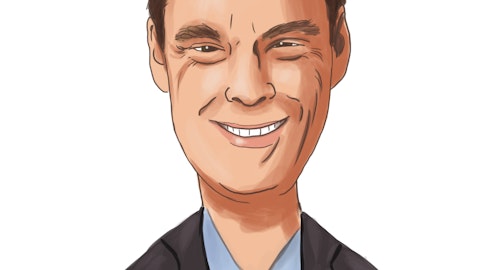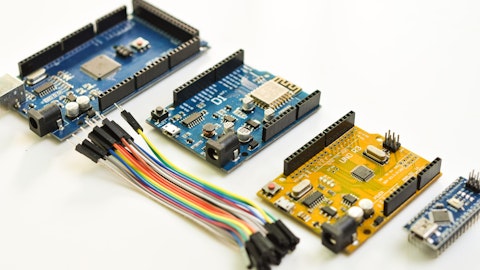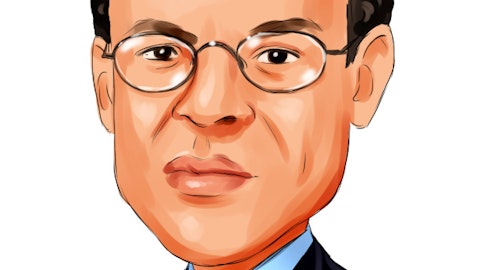Littelfuse, Inc. (NASDAQ:LFUS) Q4 2022 Earnings Call Transcript February 2, 2023
Operator: Good day, everyone, and welcome to the Littelfuse Fourth Quarter 2022 Earnings Conference Call. Today’s call is being recorded. . At this time, I will turn the call over to the Head of Investor Relations, Trisha Tuntland. Please proceed.
Trisha Tuntland: Good morning, and welcome to the Littelfuse Fourth Quarter 2022 Earnings Conference Call. With me today are Dave Heinzmann, President and CEO; and Meenal Sethna, Executive Vice President and CFO. Yesterday, we reported results for our fourth quarter and a copy of our earnings release and slide presentation is available in the Investor Relations section of our website. A webcast of today’s conference call will also be available on our website. Please advance to Slide two for our disclaimers. Our discussions today will include forward-looking statements. These forward-looking statements may involve significant risks and uncertainties. Please review yesterday’s press release and our Forms 10-K and 10-Q for more detail about important risks that could cause actual results to differ materially from our expectations.
We assume no obligation to update any of this forward-looking information. Also, our remarks today refer to non-GAAP financial measures. A reconciliation of these non-GAAP financial measures to the most comparable GAAP measure is provided in our earnings release available in the Investor Relations section of our website. I will now turn the call over to Dave.
David Heinzmann: Thank you, Trisha. Good morning, and thanks for joining us today. Let’s start with highlights on Slide four. 2022 was truly an exceptional year for Littelfuse, as we continue to expand our leadership in high-growth end markets with significant new business wins and strategic acquisitions. We delivered record revenue of $2.5 billion, up 21% over 2021, as each of our business segments grew sales double digits. Adjusted earnings per share was also a record of $16.87, an increase of 28% year-over-year. We launched our five year growth strategy in early 2021 and have delivered strong performance within the first two years, as shown on Slide five. Our strategy targets double-digit average annual growth, coupled with sustained profitability and leveraged earnings growth.
We have averaged 32% revenue growth with organic revenue growth of around 20% and average adjusted earnings growth of 60%. I am particularly proud of our success as we navigated the unprecedented operating environment. I want to thank our global teams for their hard work and persistent commitment to serve our customers and significantly grow our business. Meenal will provide additional color on our strong financial performance. Moving on to Slide six. Over the last two years, we have deployed approximately $1 billion in capital for acquisitions, adding approximately $500 million in annualized sales to further strengthen our technologies and capabilities and diversify the end market in the geographies we serve. With the ongoing diversification of our business, we have expanded our addressable global market opportunities to over $20 billion.
During 2022, we significantly advanced our strategic business initiatives within the structural growth themes of sustainability, connectivity and safety. We drove content and share gains in high-growth end markets, both organically and through acquisitions. We acquired C&K Switches, strengthening our global presence across industrial, transportation, datacom and aerospace end markets, and then expanding our software and firmware capabilities within transportation and industrial applications. In addition, our integration with Carling Technologies is well on track. And we made substantial progress capitalizing on strong demand across commercial vehicle end markets to drive significant growth. Organically, we are investing to support continued growth in both customer-facing aspects of our business as well as in manufacturing capacity and productivity.
During 2022, we advanced our ESG program initiatives, reinforcing our commitment to our long-term strategy. We set goals to increase our associate diversity and are proud of our progress shown on slide seven. We believe our recognition by Forbes as one of America’s best midsized companies, and by Newsweek as one of its most responsible companies further substantiates our performance in the environmental, social and corporate governance areas. All of our achievements to date play a crucial role in building on our strong business foundation. The evolution of our capabilities to better serve our customers equips us to tackle new challenges and opportunities in the future. We have a strong track record of achieving best-in-class results and expect to deliver our ongoing performance consistent with our growth strategy.
Before we get into business design wins, I’d like to start with customer and market dynamics we are seeing, starting with our channel partners. Our Electronics book-to-bill continues to run below 1.0. We are seeing Electronics distributors accelerate their reduction of inventory levels as supply chains and lead times normalize. We expect these inventory reductions to continue through the second quarter at current POS levels. Our Industrial distribution partners are operating within normal inventory levels. Within end markets, we continue to see ongoing softer demand across various electronic markets, including consumer-facing areas, and telecom applications. End market demand remains healthy across renewables, industrial automation and safety and electrification of vehicles and charging infrastructure.
We delivered solid performance within passenger vehicle end markets during 2022. However, this was overshadowed by unfavorable foreign exchange and inventory unwind at Tier 1s and OEMs. Absent these combined headwinds, our automotive technology portfolio across all of our businesses outgrew the market by 600 basis points. Considering the volatility of the automotive industry over recent years, we are proud of our long-term performance. Over the last three years, we have delivered double-digit content outgrowth. Looking ahead, despite our outlook for a flat global car build in 2023, we expect to continue to outperform the market based on significant design wins in electrification and electronification. In commercial vehicle end markets, we continue to see stable demand across material handling, agriculture and construction equipment and heavy-duty truck and bus.
With our successful integration of Carling throughout 2022, we fulfilled a strong backlog to achieve 20% growth over its previous stand-alone year. We now see a short-term inventory rebalancing of Carling products at distributors and in customers. Meenal will provide additional color on our outlook. Now let’s move on to business design wins during 2022. The global structural themes of sustainability, connectivity and safety are complementary and are driving innovation and growth across the Industrial, Transportation and electronics end markets we serve. Given our diversified technologies and capabilities, we play a significant role in the advancement of these themes. Within our Industrial end markets on Slide eight, we expanded our global leadership presence based on technical expertise and high-performing technologies.
Our capabilities are critical to enabling customers high-voltage applications focused on sustainability and safety. In renewables, for solar, wind and energy storage systems, our company-wide portfolio and a variety of new products won a significant business to grow our market share. In the area of safety, evolving electrical standards require our application expertise, and innovative solutions to achieve compliance. We substantially grew our market position with major restaurant chains and manufacturing companies. In Commercial and Residential HVAC, systems are required to meet energy efficiency and safety standards and a broad portfolio of secured sizable business. Efficiency and safety requirements also pertain to electrical infrastructure, motor drives, power supplies, factory automation and manufacturing equipment where we grew our business.
Our product content and rates of new business wins is increasing with leading customers, and we expect this to continue based on our capabilities and intensifying focus on enabling applications around sustainability and safety. Turning to our Transportation end markets on Slide nine, our investments for growth are extending our leadership position. We are partnering with our customers to drive key developments in the electrification and electronification of passenger and commercial vehicles. Our joint collaboration focused on sustainability, connectivity and safety drove significant new business. In passenger vehicles, we continue to grow with major OEMs based on our global technical support and strength of our product portfolio. As a result, our average content across passenger vehicles has grown to $7.
Our ability to continue our growth is supported by our design wins. Across vehicle platforms, we secured over $550 million in new design wins over the life of the programs. Over half of these new business wins are on electrified platforms. We won significant business in electrification within battery management systems, high-voltage power distribution and onboard chargers. In electronification, we captured a substantial business in ADAS, infotainment, telematics and comfort convenience applications. We also continue to expand our business in traditional low-voltage applications, our design wins, extended pipeline of new business opportunities and expanding technologies for electrified platforms to support the continuation of double-digit content outgrowth.
In commercial vehicles, we made significant progress integrating Carling and see a broad range of growth opportunities ahead of us. We leveraged our expanded offerings to win global business with major OEMs. In electrification, we grew our business in trucks, buses and two and three wheelers within battery management systems, onboard chargers and powertrain control modules. In broader commercial vehicle markets, we increased our product content on heavy-duty trucks, material handling, construction and agricultural equipment and rail traction for training. With off-board charging infrastructure to support passenger and commercial vehicles, our engineering capabilities and differentiated range of products in power semiconductors, fuses, relays and switches, secured significant new business.
Overall, electrification and electronification are important themes in the Transportation industry that are helping to reduce emissions and improve efficiencies, connectivity and safety. We are confident in our abilities investments in e-mobility will strengthen our market leadership through greater product content and growth. Moving on to Slide 10. Sustainability, connectivity and safety are drivers of growth in the electronics end markets. We leveraged our global reach and broad portfolio, further enhanced with C&K and Carline who have extended relationship with OEMs to secure a multi-technology business wins. With the ongoing push towards energy efficiency and battery power business and appliances and hand tools. Greater connectivity requirements drove new business in data centers, telecom infrastructure and building technologies and automation.
Our products are vital to safety and protection of human life as we secure business for security systems and a variety of medical device. We are extremely well positioned to expand the proliferation of our electronics content across a wide range of applications focused on sustainability, connectivity and safety. A pipeline of new business opportunities is robust and expanding with our acquisitions. We look forward to building on our collective market positions with our various industry-leading brands. Our combined success of winning business will serve as a platform for continued growth. Our new business wins represented a diverse range of end markets, applications and geographies. We also continue to build a pipeline of identified new business opportunities as we see our customers’ engineering teams return to focus on new product development.
Now that customers have worked through many supply chain challenges, they have pivoted back to new design in activity, which is accelerating. We are well positioned within this design-rich environment, which will drive long-term business wins. We fully expect that the organic growth from the new business activities, coupled with our acquisitions will enhance and sustain our long-term growth. I will now turn the call over to Meenal to provide additional color on our financial performance and outlook.

electronics-6055226_1280
Meenal Sethna: Thanks, Dave. Good morning, everyone. Happy New Year, and thank you for joining us today. Let’s start with Slide 12. Revenue in the fourth quarter was $613 million, up 11% versus last year. Sales were up 4% organically after adjusting for acquisitions, foreign exchange and last year’s 14th week. GAAP operating margins were 15.4% and adjusted margins 17.4%, expanding 40 basis points versus last year. Fourth quarter GAAP diluted earnings per share was $3.74 and adjusted diluted EPS was $3.34, up 6% over last year. Turning to Slide 13. we finished a record year with sales of $2.51 billion, up 21% versus last year. Sales were up 11% organically after adjusting for acquisitions, foreign exchange and last year’s 14th week in the fourth quarter.
GAAP operating margins were 19.9%. Adjusted operating margins finished at 21.6% and adjusted EBITDA margins were 26.4%, both expanding 250 basis points in the year. Incremental operating margins for the year were 34%. We finished the year positive on price cost, continuing to demonstrate the value we bring to our customers, while managing our cost structure. GAAP diluted EPS was $14.94, adjusted diluted EPS was $16.87, up 28% versus last year. Our full year GAAP effective tax rate was 15.7% and adjusted effective tax rate was 17.4%, finishing slightly better than our expectations. Our business model amplifies the continued strength of our cash generation. For the year, operating cash flow was $420 million and free cash flow $315 million, both records for the company and growing 12%.
Our free cash flow conversion from net income was 84%, a bit lower than our historical trends as we’ve maintained higher inventory levels, aligning to our customers’ needs and supply chain challenges. We have a strong balance sheet and capital structure, ending 2022 with over $550 million in cash on hand and net debt-to-EBITDA leverage of 1.2 times. This gives us ongoing flexibility to continue allocating capital for both growth and return to shareholders. During 2022, we invested over $600 million back into our business through strategic acquisitions and capital expenditures, and we returned $56 million to shareholders through our ongoing quarterly dividends. Let’s move to fourth quarter and full year segment highlights, starting with Electronics on Slide 14.
Within the quarter, organic growth was 2%. We saw continued strength across Industrial end markets and electrification themes, partly offset by softer demand across various Electronics end markets. We also saw an increasing trajectory in channel inventory reductions as we exited the quarter. We ended the quarter with operating margins just shy of 25%, expanding 160 basis points versus last year. We capped the year with organic revenue growth of 12%. Margins finished at nearly 29% for the year and adjusted EBITDA margins at 33.5%, both expanding 500 basis points versus last year and well above our segment target range. We finished the year positive on price cost as our teams balanced price increases to offset ongoing inflationary costs. Moving to our Transportation segment on Slide 15.
Our Passenger Vehicle business grew 5% organically in the quarter and was down 1% for the year. Our content growth for the year was masked by customers continuing to reduce inventory levels. Within Commercial Vehicles, sales for the quarter were up 7% organically and up 9% for the year as we delivered on content growth while leveraging strong end markets. We saw a sequential sales decline into the fourth quarter, largely from our Carling business. Following several quarters of strong demand from pent-up backlog, we experienced fourth quarter slowdown from Carling customers also adjusting their inventory levels. Within the quarter, operating margins finished lower than our expectations at 3.5%, but we maintained double-digit EBITDA level. Margins were weakened by 200 basis points in unfavorable foreign exchange effects as well as excess cost from lower production volumes.
For the year, operating margins finished at nearly 9%, while adjusted EBITDA margins were a solid 15%. We continue to focus on both sides of the price/cost equation, implementing price actions to cover ongoing inflation and reducing cost to better align our operating structure to expected volumes. We expect margins to progressively improve in the coming quarters. On Slide 16, our Industrial segment had another strong quarter of double-digit organic growth, with organic sales finishing up 20% for the year. We continue to see strong demand across most end markets and number of wins in new and higher growth end markets. Operating margins finished at 16% for the year and adjusted EBITDA margins close to 19%, both expanding 700 basis points. Our teams have focused on continued operational execution aligned to the volume growth and pricing actions to offset inflationary trends.
Turning to the forecast on Slide 17, I’ll start with our view of the market landscape. We’re seeing a broad range of signals across our end markets, ranging from continued growth across key mobility themes, Industrial and Commercial Vehicle markets, offset by weakness across many of our Electronics end markets. We expect increased inventory rebalancing at our distribution channel partners continuing through the first half of this year, affecting our Electronics segment. We also expect a continuation of customer inventory reductions affecting our Transportation segment. Inflationary trends continue largely in resin-based materials, energy costs and wages with some offsets from reduced transportation costs. With this backdrop, we expect first quarter sales in the range of $575 million to $605 million.
At the midpoint, that’s a total sales decline of 5% and organic decline of 11% versus last year. We expect sales to decline across both the electronics and transportation segments due to the inventory reduction at our customers and channel partners. We expect a partial offset with growth in the Industrial segment. We project adjusted EPS to be in the range of $2.73 to $2.97, which includes a 19% tax rate. As a reminder, first quarter last year was a record for the company due to mix and elevated backlog and a much more robust macro environment. This creates a challenging comparable for the first quarter of 2023. Sequentially, we expect first quarter adjusted earnings to decline 15%, reflecting the segment mix of electronics sales declining sequentially, partially offset by sales growth across the Industrial and Transportation.
Turning to Slide 18, I’ll add some color for the full year 2023. Last quarter, we estimated foreign exchange to have a $50 million negative sales impact for the full year. At current rates, we don’t expect foreign exchange to have a material impact to our 2023 sales or earnings. For the year, we expect to maintain our company average operating margin within our long-term target range of 17% to 19%, but may vary by quarter out of the range. By segment, we’re projecting Electronics operating margins to average over 20%, Industrial in the upper teens and Transportation improving through the year with double-digit operating margins in the back half of the year. In addition, we’re projecting $64 million in amortization expense and about $40 million in interest expense at current interest rates.
We’re estimating a full year tax rate of 18% and we expect to invest $110 million to $120 million in capital expenditures. In summary, the continued broadening of our portfolio, end markets and geographies have enabled us to drive profitable growth across the company. While we may see some near-term macro weakness and customer inventory reductions impacting parts of our business, we will continue balancing both the short term and the long term. Our near-term focus will be on margin optimization, prioritizing our transportation segment. And our long-term priority remains investing for content growth and share gains into high-growth end markets. Our strong balance sheet and cash generation abilities give us the ongoing foundation to invest for value creation.
I’d like to thank our diverse teams and partners around the world for their innovation, capabilities and dedication in driving a record year for our company. And with that, I’ll turn it back to Dave for some final comments.
David Heinzmann: Thanks, Meenal. In summary, on Slide 19, our talented associates, investments for growth and operational excellence have delivered record performance in 2022. Our track record of double-digit sales and earnings growth over the last five, 10 and 15 years speaks to the resiliency of the Littelfuse’s business model and the strength of our growth strategy. Over this time, we have expanded our leadership and presence in high-growth end markets, technologies and geographies which has diversified our business and improved the resiliency of our profitability. But we may see some near-term market challenges, we are better diversified today and have honed our playbook to successfully manage through dynamic environments. Our experienced teams, investments in diversification position us for continued growth and will deliver ongoing substantial value to all of our stakeholders. And with that, I will now turn the call back to the operator for Q&A.
See also 11 Most Undervalued Foreign Stocks To Buy and 15 Most Undervalued NASDAQ Stocks.
Q&A Session
Follow Littelfuse Inc (NASDAQ:LFUS)
Follow Littelfuse Inc (NASDAQ:LFUS)
Operator: Our first question will come from the line of Matt Sheerin with Stifel. Please go ahead.
Matthew Sheerin: Hi. Good morning. First question regarding the outlook for the Electronics business. You’re talking about channel inventory correction. Could you give us an idea of what the channel inventories look like versus normalized levels? And what makes you think things are going to sort of bottom out in Q3 or Q2? The distributors are talking about having elevated levels up again this quarter. It sounds like it’s going to take longer for them to work it down. So what kind of visibility do you have into that?
David Heinzmann: Sure. Thanks, Matt. And we’ve talked historically about the fact with our electronics distribution channels that kind of on average across the globe and across the different types of distributors. 14 to 17 weeks is really kind of our normal range that we choose to operate. And what I would say is that it varies, our weeks of inventory varies across the product lines. We have some of our core product lines that are a couple of weeks above that range. We also have some other product lines like our power semiconductor products that are on the bottom end of the range, and have really strong backlogs. So it’s a bit of a mixed bag between them. But clearly, there’s accelerating actions by our distribution partners to drive their inventory levels down.
I know you were on calls with Avnet and Arrow’s released today. And obviously, their inventories are pretty high. Right now, while our distributors book-to-bills are slightly below one. POS is still hanging in at a pretty good level out there. So kind of all of our views are really based on where are we at the current POS levels across the globe, and how does that drive our inventory actions for us. Obviously, you saw a little bit in the fourth quarter where these actions began to take place. So already inventory corrections were taking place in the fourth quarter. They’re certainly accelerating into the first quarter. So it’s our current view at the current POS levels and things like that, it should work our way through that through the kind of the first half of the year.
But the reality is, as you know, cycles are kind of difficult to predict, and it’s been a pretty unpredictable last two or three years, and it may be unpredictable this year as well. That’s why we’re kind of really looking one quarter out.
Matthew Sheerin: Fair enough. And then regarding the operating margin guide for the year of 17% to 19%, you’re starting off in the low 16% range as you’re guiding here. And I would think that Electronics would continue to be depressed or even maybe margins down in the June quarter. So what’s going to drive those margins back to that 17% to 19% range?
Meenal Sethna: Sure. Thanks, Matt. It in part aligns to what Dave just talked about, right? Which is, as we look out and look out at the landscape at current dynamics and current POS levels, specifically around Electronics, we would expect from where we sit today, a couple of quarters continuing of inventory destocking, but if POS levels continue to remain where they are we would see improving margins as our sales aligns to that. The other thing is in some of our prepared commentary I also talked about improving Transportation margins, and also talked about really maintaining margins in our target range across our Industrial segment. So the combination of all that gives us confidence when we think about total company aligned to that range on average for the year.
Matthew Sheerin: Okay. That’s helpful. Okay, thank you very much.
Trisha Tuntland: Thanks, Matt. We will take our next question please.
Operator: Our next question will come from the line of Luke Junk with Baird. Please go ahead.
Trisha Tuntland: Good morning, Luke.
Luke Junk: Good morning, Trisha. Thanks for taking my questions everyone. I want to start with the margin question on Electronics. It’s more of a mechanical question really. Could you just help us understand how that business should flex as growth turns negative here to start 2023? Specifically, we’re hoping to tease out any differences between the passive side of your portfolio in the semiconductor business. I know the latter has some higher capital costs. So I just want to understand the margin dynamics given your sales guidance. Thank you.
Meenal Sethna: Yes. I mean overall across our Electronics segment, right, margins — the margins in that segment are the strongest across the portfolio. So when we see flexes up in growth, we get very strong incrementals and then the opposite happens on the decremental side. So there are different varying margin ranges across all of our products. But in general, we just look at the Electronics segment in aggregate. And know that compared to maybe other parts of our portfolio, like Transportation or Industrial, stronger incrementals and so also on the flip side some higher decremental margins. And as — I know there were some of the questions about Q3 to Q4, we see that Q4 going into the Q1 forecast, and that’s really what we’re seeing there as we see that sequential sales decline going into the first quarter.
Luke Junk: Thanks for that Meenal. And then staying with margins, could you just to the level of growth that you’re contemplating to get to high teen margins in the industrial business this year. I know you’ve been targeting that. Longer term, I just wanted to understand growth dynamics and to what extent integration, especially Carling is being potentially reflected in that commentary as well incrementally. Thank you.
Meenal Sethna: Sure. Let me just high levels we think about segments. We talked about from where we sit today, the Industrial markets remain strong. So we remain positive on that segment and where we sell into Industrial markets. We’re confident in our above-market content outgrowth coming through across Transportation. We think that will be solid as well even across our Electronics segment, right, where we’re selling into a lot of markets that cover Electrification, that cover Industrial markets, et cetera. We expect to continue that to be what we’re seeing today. Couple that with ongoing work that we’re doing across Carling with synergy realization, with C&K synergy realization. And just in general, work that we’re doing around the Transportation margin profile overall. That’s really what continues to give us confidence in that 2023 target in that 17% to 19% range.
Luke Junk: Okay. I’ll leave it there.





